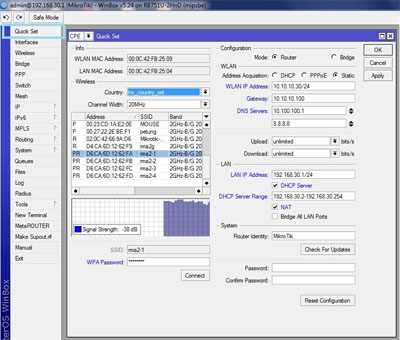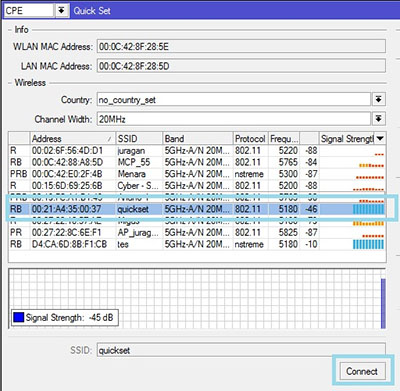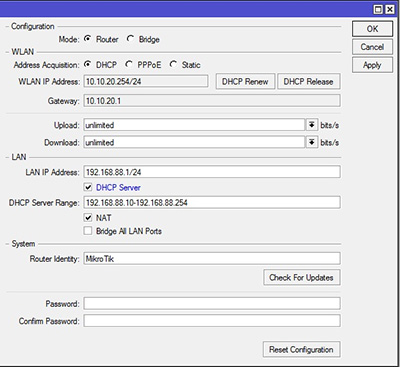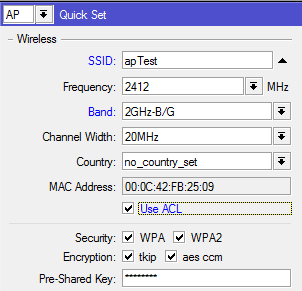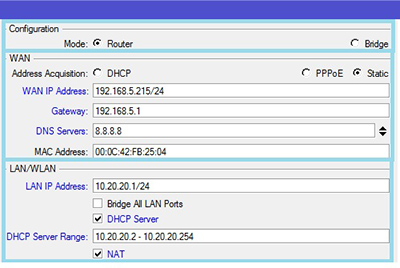A
wireless network is any type of
computer network that uses wireless data connections for connecting
network nodes.
Wireless networking is a method by which homes,
telecommunications networks
and enterprise (business) installations avoid the costly process of
introducing cables into a building, or as a connection between various
equipment locations.
[1] Wireless telecommunications networks are generally implemented and administered using
radio communication. This implementation takes place at the physical level (layer) of the
OSI model network structure.
[2]
Examples of wireless networks include cell phone networks, Wi-Fi local networks and terrestrial microwave networks.
Wireless links

Computers are very often connected to networks using wireless links
- Terrestrial microwave –
Terrestrial microwave communication uses Earth-based transmitters and
receivers resembling satellite dishes. Terrestrial microwaves are in the
low-gigahertz range, which limits all communications to line-of-sight.
Relay stations are spaced approximately 48 km (30 mi) apart.
- Communications satellites –
Satellites communicate via microwave radio waves, which are not
deflected by the Earth's atmosphere. The satellites are stationed in
space, typically in geosynchronous orbit 35,400 km (22,000 mi) above the
equator. These Earth-orbiting systems are capable of receiving and
relaying voice, data, and TV signals.
- Cellular and PCS systems use several radio communications
technologies. The systems divide the region covered into multiple
geographic areas. Each area has a low-power transmitter or radio relay
antenna device to relay calls from one area to the next area.
- Radio and spread spectrum technologies –
Wireless local area networks use a high-frequency radio technology
similar to digital cellular and a low-frequency radio technology.
Wireless LANs use spread spectrum technology to enable communication
between multiple devices in a limited area. IEEE 802.11 defines a common flavor of open-standards wireless radio-wave technology known as Wifi.
Types of wireless networks
Wireless PAN
Wireless
personal area networks (WPANs) interconnect devices within a relatively small area, that is generally within a person's reach.
[3] For example, both
Bluetooth radio and invisible
infrared light provides a WPAN for interconnecting a headset to a laptop.
ZigBee also supports WPAN applications.
[4]
Wi-Fi PANs are becoming commonplace (2010) as equipment designers start
to integrate Wi-Fi into a variety of consumer electronic devices.
Intel "My WiFi" and
Windows 7 "
virtual Wi-Fi" capabilities have made Wi-Fi PANs simpler and easier to set up and configure.
[5]
Wireless LAN
Main article:
Wireless LAN
A wireless local area network (WLAN) links two or more devices over a
short distance using a wireless distribution method, usually providing a
connection through an access point for
Internet access. The use of
spread-spectrum or
OFDM technologies may allow users to move around within a local coverage area, and still remain connected to the network.
Products using the
IEEE 802.11 WLAN standards are marketed under the
Wi-Fi brand name.
Fixed wireless technology implements
point-to-point links between computers or networks at two distant locations, often using dedicated
microwave or modulated
laser light beams over
line of sight paths. It is often used in cities to connect networks in two or more buildings without installing a wired link.
Wireless mesh network
A wireless mesh network is a wireless network made up of radio nodes
organized in a mesh topology. Each node forwards messages on behalf of
the other nodes. Mesh networks can "self heal", automatically re-routing
around a node that has lost power.
Wireless MAN
Wireless
metropolitan area networks are a type of wireless network that connects several wireless LANs.
Wireless WAN
Wireless wide area networks
are wireless networks that typically cover large areas, such as between
neighboring towns and cities, or city and suburb. These networks can be
used to connect branch offices of business or as a public internet
access system. The wireless connections between access points are
usually
point to point microwave links using
parabolic dishes on the 2.4 GHz band, rather than
omnidirectional antennas
used with smaller networks. A typical system contains base station
gateways, access points and wireless bridging relays. Other
configurations are mesh systems where each access point acts as a relay
also. When combined with renewable energy systems such as photo-voltaic
solar panels or wind systems they can be stand alone systems.
Cellular network

Example of frequency reuse factor or pattern 1/4
A
cellular network or
mobile network is a radio network distributed over land areas called cells, each served by at least one fixed-location
transceiver, known as a
cell site or
base station.
In a cellular network, each cell characteristically uses a different
set of radio frequencies from all their immediate neighbouring cells to
avoid any interference.
When joined together these cells provide radio coverage over a wide
geographic area. This enables a large number of portable transceivers
(e.g., mobile phones,
pagers,
etc.) to communicate with each other and with fixed transceivers and
telephones anywhere in the network, via base stations, even if some of
the transceivers are moving through more than one cell during
transmission.
Although originally intended for cell phones, with the development of
smartphones,
cellular telephone networks routinely carry data in addition to telephone conversations:
- Global System for Mobile Communications
(GSM): The GSM network is divided into three major systems: the
switching system, the base station system, and the operation and support
system. The cell phone connects to the base system station which then
connects to the operation and support station; it then connects to the
switching station where the call is transferred to where it needs to go.
GSM is the most common standard and is used for a majority of cell
phones.[7]
- Personal Communications Service
(PCS): PCS is a radio band that can be used by mobile phones in North
America and South Asia. Sprint happened to be the first service to set
up a PCS.
- D-AMPS:
Digital Advanced Mobile Phone Service, an upgraded version of AMPS, is
being phased out due to advancement in technology. The newer GSM
networks are replacing the older system.
Global area network
A
global area network
(GAN) is a network used for supporting mobile across an arbitrary
number of wireless LANs, satellite coverage areas, etc. The key
challenge in mobile communications is handing off user communications
from one local coverage area to the next. In IEEE Project 802, this
involves a succession of terrestrial
wireless LANs.
[8]
Space network
Space networks are networks used for communication between
spacecraft, usually in the vicinity of the Earth. The example of this is
NASA's
Space Network.
Different uses
Some examples of usage include cellular phones which are part of
everyday wireless networks, allowing easy personal communications.
Another example, Inter-continental network systems, use radio
satellites to communicate across the world.
Emergency services
such as the police utilize wireless networks to communicate effectively
as well. Individuals and businesses use wireless networks to send and
share data rapidly, whether it be in a small office building or across
the world.
Properties
General
In a general sense, wireless networks offer a vast variety of uses by both business and home users.
[9]
"Now, the industry accepts a handful of different wireless
technologies. Each wireless technology is defined by a standard that
describes unique functions at both the Physical and the Data Link layers
of the OSI Model. These standards differ in their specified signaling
methods, geographic ranges, and frequency usages, among other things.
Such differences can make certain technologies better suited to home
networks and others better suited to network larger organizations."[9]
Performance
Each standard varies in geographical range, thus making one standard
more ideal than the next depending on what it is one is trying to
accomplish with a wireless network.
[9]
The performance of wireless networks satisfies a variety of
applications such as voice and video. The use of this technology also
gives room for expansions, such as from
2G to
3G and, most recently,
4G
technology, which stands for fourth generation of cell phone mobile
communications standards. As wireless networking has become commonplace,
sophistication increases through configuration of network hardware and
software, and greater capacity to send and receive larger amounts of
data, faster, is achieved.
[10]
Space
Space is another characteristic of wireless networking. Wireless
networks offer many advantages when it comes to difficult-to-wire areas
trying to communicate such as across a street or river, a warehouse on
the other side of the premise or buildings that are physically separated
but operate as one.
[10]
Wireless networks allow for users to designate a certain space which
the network will be able to communicate with other devices through that
network. Space is also created in homes as a result of eliminating
clutters of wiring.
[11] This technology allows for an alternative to installing physical network mediums such as
TPs,
coaxes, or
fiber-optics, which can also be expensive.
Home
For homeowners, wireless technology is an effective option compared to
ethernet
for sharing printers, scanners, and high speed internet connections.
WLANs help save the cost of installation of cable mediums, save time
from physical installation, and also creates mobility for devices
connected to the network.
[11] Wireless networks are simple and require as few as one single
wireless access point connected directly to the Internet via a
router.
[9]
Wireless Network Elements
The telecommunications network at the physical layer also consists of many interconnected wireline
Network Elements (NEs).
These NEs can be stand-alone systems or products that are either
supplied by a single manufacturer, or are assembled by the service
provider (user) or system integrator with parts from several different
manufacturers.
Wireless NEs are products and devices used by a wireless carrier to provide support for the
backhaul network as well as a
Mobile Switching Center (MSC).
Reliable wireless service depends on the network elements at the
physical layer to be protected against all operational environments and
applications (see GR-3171,
Generic Requirements for Network Elements Used in Wireless Networks - Physical Layer Criteria).
[12]
What are especially important are the NEs that are located on the cell tower to the
Base Station (BS)
cabinet. The attachment hardware and the positioning of the antenna and
associated closures/cables are required to have adequate strength,
robustness, corrosion resistance, and rain/solar resistance for expected
wind, storm, ice, and other weather conditions. Requirements for
individual components, such as hardware, cables, connectors, and
closures, shall take into consideration the structure to which they are
attached.
Difficulties
- Interference
- Compared to wired systems, wireless networks are frequently subject to electromagnetic interference.
This can be caused by other networks or other types of equipment that
generate radio waves that are within, or close, to the radio bands used
for communication. Interference can degrade the signal or cause the
system to fail.
- Absorption and reflection
- Some materials cause absorption
of electromagnetic waves, preventing it from reaching the receiver, in
other cases, particularly with metallic or conductive materials
reflection occurs. This can cause dead zones where no reception is
available.
- Multipath fading
- In multipath fading
two or more different routes taken by the signal, due to reflections,
can cause the signal to cancel out at certain locations, and to be
stronger in other places (upfade).
- Hidden node problem
- The hidden node problem occurs in some types of network when a node is visible from a wireless access point (AP), but not from other nodes communicating with that AP. This leads to difficulties in media access control.
- Shared resource problem
- The wireless spectrum is a limited resource and shared by all nodes in the range of its transmitters. Bandwidth allocation becomes complex with multiple participating users. Often users are not aware that advertised numbers (e.g., for IEEE 802.11 equipment or LTE
networks) are not their capacity, but shared with all other users and
thus the individual user rate is far lower. With increasing demand, the capacity crunch is more and more likely to happen. User-in-the-loop (UIL) may be an alternative solution to ever upgrading to newer technologies for over-provisioning.
Capacity
Channel

Understanding of SISO, SIMO, MISO and
MIMO.
Using multiple antennas and transmitting in different frequency
channels can reduce fading, and can greatly increase the system
capacity.
The maximum data rate of any single wireless link can be described by the
Shannon's theorem which is related to the bandwidth in hertz, and the noise on the channel.
Network
![[icon]](http://upload.wikimedia.org/wikipedia/commons/thumb/1/1c/Wiki_letter_w_cropped.svg/20px-Wiki_letter_w_cropped.svg.png) |
This section requires expansion. (April 2013) |
The total network bandwidth depends on how dispersive the medium is
(more dispersive medium generally has better total bandwidth because it
minimises interference), how many frequencies are available, how noisy
those frequencies are, how many aerials are used and whether directional
antenna are in use, whether nodes employ power control and so on.
Cellular wireless networks generally have good capacity, due to their
use of directional aerials, and their ability to reuse radio channels
in non-adjacent cells. Additionally, cells can be made very small using
low power transmitters, and this fact is used in cities to give network
capacity that scales linearly with population density.
Safety
Wireless access points are also often close to humans, but the drop off in power over distance is fast, following the
inverse-square law.
[13] The position of the
United Kingdom's
Health Protection Agency
(HPA) is that “...radio frequency (RF) exposures from WiFi are likely
to be lower than those from mobile phones.” It also saw “...no reason
why schools and others should not use WiFi equipment.”
[14]
In October 2007, the HPA launched a new “systematic” study into the
effects of WiFi networks on behalf of the UK government, in order to
calm fears that had appeared in the media in a recent period up to that
time".
[15] Dr Michael Clark, of the HPA, says published research on mobile phones and
masts does not add up to an indictment of WiFi.
[16]
See also
References
Further reading
- Wireless
Networking in the Developing World: A practical guide to planning and
building low-cost telecommunications infrastructure (2nd ed.). Hacker Friendly LLC. 2007. p. 425.
- Pahlavan, Kaveh; Levesque, Allen H (1995). Wireless Information Networks. John Wiley & Sons. ISBN 0-471-10607-0.
- Geier, Jim (2001). Wireless LANs. Sams;. ISBN 0-672-32058-4.
- Goldsmith, Andrea (2005). Wireless Communications. Cambridge University Press. ISBN 0-521-83716-2.
- Molisch, Andreas (2005). Wireless Communications. Wiley-IEEE Press. ISBN 0-470-84888-X.
- Pahlavan, Kaveh; Krishnamurthy, Prashant (2002). Principles of Wireless Networks – a Unified Approach. Prentice Hall. ISBN 0-13-093003-2.
- Rappaport, Theodore (2002). Wireless Communications: Principles and Practice. Prentice Hall. ISBN 0-13-042232-0.
- Rhoton, John (2001). The Wireless Internet Explained. Digital Press. ISBN 1-55558-257-5.
- Tse, David; Viswanath, Pramod (2005). Fundamentals of Wireless Communication. Cambridge University Press. ISBN 0-521-84527-0.
- Kostas Pentikousis (March 2005). "Wireless Data Networks". Internet Protocol Journal 8 (1). Retrieved 29 August 2011.
- Pahlavan, Kaveh; Krishnamurthy, Prashant (2009). Networking Fundamentals – Wide, Local and Personal Area Communications. Wiley. ISBN 978-0-470-99290-6.
External links
 Sebelum
anda membaca tips berikut ini, kami beritahukan kalau tips ini hanya
untuk pemula saja. Jika anda sudah mahir dan berpengalaman dengan
komputer dan seputar dunia windows, silahkan anda baca artikel lain saja
yang lebih bermanfaat!
Sebelum
anda membaca tips berikut ini, kami beritahukan kalau tips ini hanya
untuk pemula saja. Jika anda sudah mahir dan berpengalaman dengan
komputer dan seputar dunia windows, silahkan anda baca artikel lain saja
yang lebih bermanfaat! 







